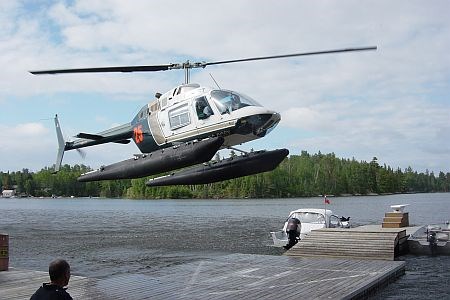Mineral exploration in northwestern Ontario is driving the growth of a Kenora helicopter company.
Bart Stevenson, president of Forest Helicopters Inc., said despite a tough economy, the demand for airborne work is “better than what we expected.”
Several juniors have mothballed properties and cut back exploration programs to preserve cash, but there remains enough activity to keep Stevenson and his company flying.
“We're comfortable with what we have,” said Stevenson, whose operation is headquartered at his home, a ten-minute drive north of Kenora.
Three of his aircraft are flying in Nunavut for uranium mining giants Cameco and Areva Resources. One is in Pickle Lake on contract for Bell Canada. Another is in Marathon working for a drilling company. Yet another is stationed near Sioux Lookout with an airborne geophysics outfit.
The company does a wide variety of work ranging from fire suppression to power line maintenance to aerial seeding for customers like Hydro One and the Ministry of Natural Resources. Their coverage area extends from Saskatchewan to Quebec and up into the Far North.
“Our expansion was driven by the mining industry,” said Stevenson. “We see a big change from last year but we're pleasantly surprised on how much we are still doing with junior mining and bigger companies.”
Forest Helicopters started in 1997 with one helicopter. Because of the demand from exploration companies, the fleet was expanded after picking up the assets of the financially troubled Midwest Helicopters.
Forest has one Bell 206 Jet Ranger and six AS 350 (A-star) Eurocopters. Another is on order for next year. A former Midwest owner, Norm Jones, even came over to be chief pilot.
On the payroll, he has 12 pilots, five engineers, two apprentice engineers and two office staff.
“We've outgrown our facilities and we're making do but we haven't made that big step. We've entertained the idea of building a new facility at the Kenora airport.”
Northwestern Ontario is a blossoming exploration camp and Stevenson keeps on top of all the activity.
The Ontario Geological Survey's District Geologist Craig Ravnaas said junior miners use local flight services to fly supplies, core samples to assay labs, and reposition drill rigs into remote areas near Red Lake and Nestor Falls.
Stevenson is a frequent visitor to his Kenora office.
“He's been aggressive the last couple of years,” said Ravnaas. “He comes in, does his research and gets our ROA (Report of Activities) and sees who's working where and makes the phone calls.”
The recession forced the company to lower rates to keep and accommodate traditional customers.
On the positive side, Stevenson said there are more qualified candidates in the job market and he's been able to recruit experienced pilots, including one from New Zealand, who flies during the summer.
“Last year with pilots and crew it was almost impossible to find people with experience. This year there are a lot more available.”
Though mining analysts predict a tough road ahead for the industry and tight capital markets, Stevenson takes a prospector's attitude.
He has aerial exploration work on the horizon with Goldcorp in the Far North next winter and one Sudbury junior, Northern Superior Resources, is very active with some promising gold properties.
“It just turned off like a tap, but we know it's going to come back just as fast.”
www.foresthelicopters.com




